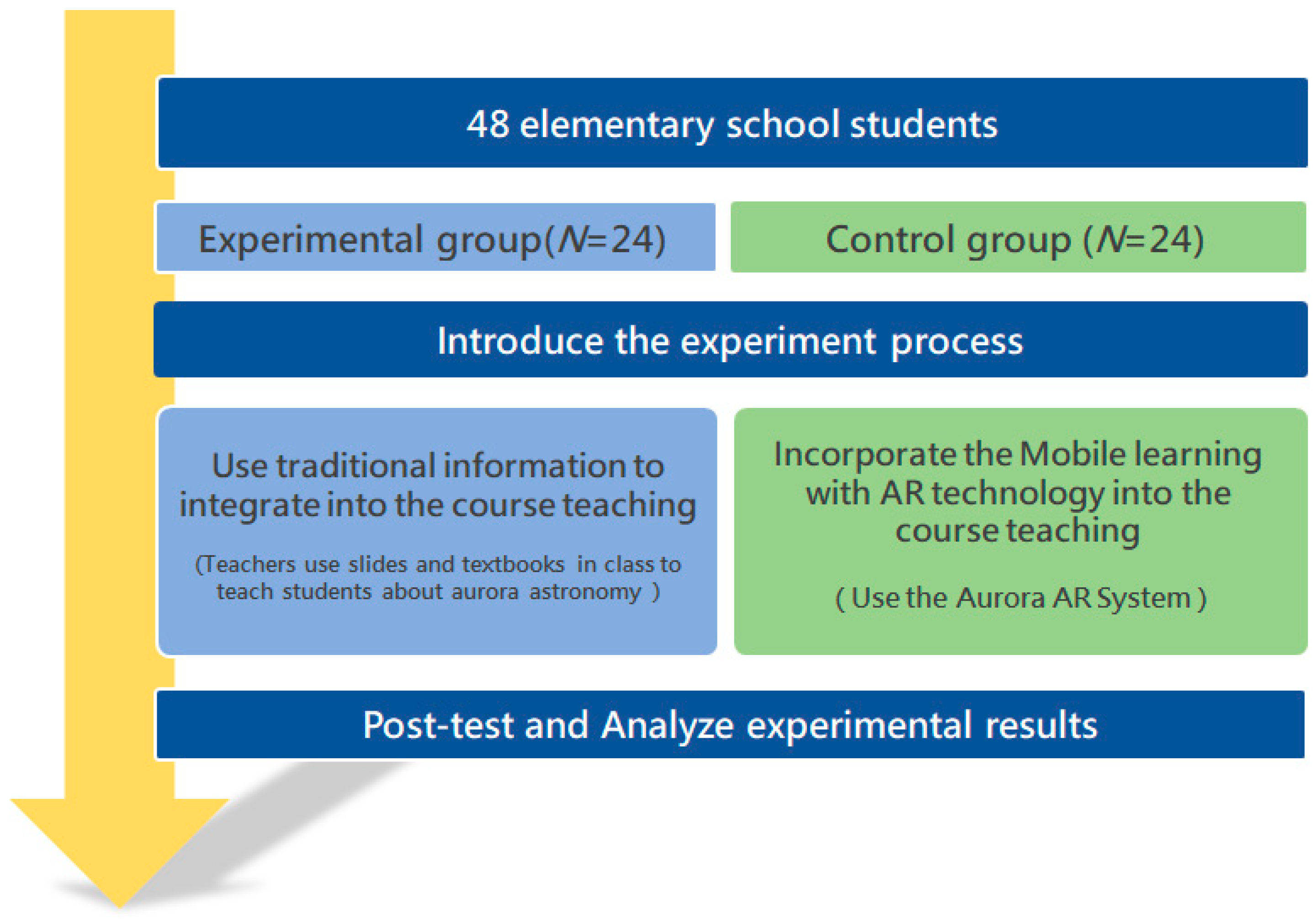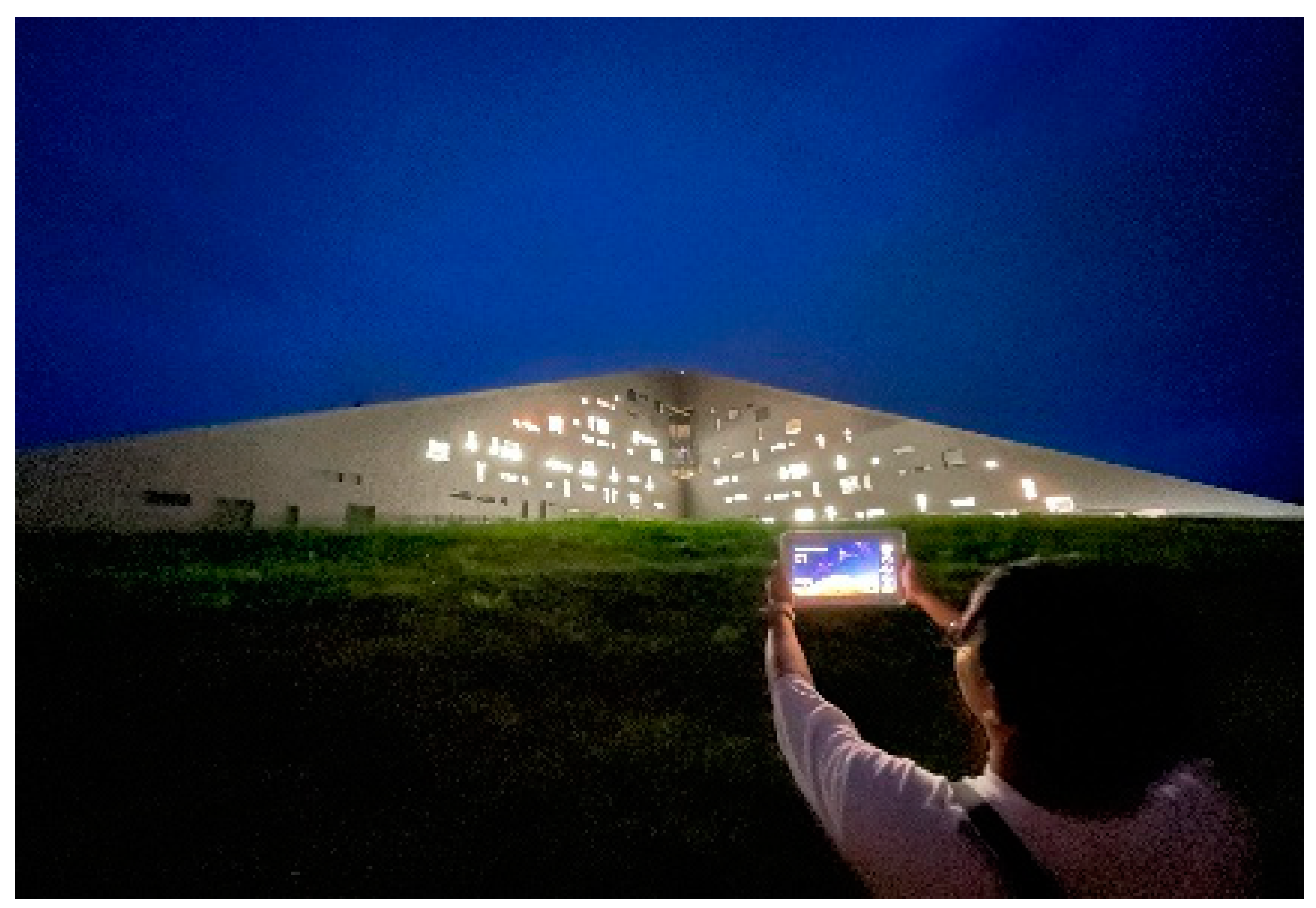Enhancing Education on Aurora Astronomy and Climate Science Awareness through Augmented Reality Technology and Mobile Learning
Abstract
1. Introduction
- To enhance students’ motivation and interest in learning by utilizing AR combined with mobile learning;
- To observe and measure whether AR, in conjunction with mobile learning, provides substantial assistance in terms of learning outcomes and increased motivation;
- To introduce the concept of auroras in the context of broader climate science discussions, focusing on student awareness rather than direct causation.
2. Related Works
2.1. Augmented Reality Technology in Science Education
2.2. Mobile Learning on Climate Change Education
3. Pedagogical Principles Underlying the Educational Activity
4. Learning Environment, Learning Objectives, and Pedagogical Format
4.1. Learning Environment
4.2. Learning Objectives
4.3. Pedagogical Format
5. Results and Extended Discussion
5.1. Pre-Test of Learning Outcomes
5.2. Post-Test of Learning Outcomes
5.3. Implications for Learning Motivation
5.4. Extended Research and Implementation
5.5. Psycho-Physiological Impacts
5.6. Equity in Education
6. Discussion on the Practical Implications, Objectives, and Lessons Learned
6.1. Enhanced Learning Outcomes and Motivation
6.2. Future Directions
Author Contributions
Funding
Institutional Review Board Statement
Informed Consent Statement
Data Availability Statement
Conflicts of Interest
References
- Efrat, E. Climate change education: The problem with walking away from disciplines. Stud. Sci. Educ. 2022, 58, 231–264. [Google Scholar]
- Carlie, D.T. Climate change education for transformation: Exploring the affective and attitudinal dimensions of children’s learning and action. Environ. Educ. Res. 2022, 28, 1023–1042. [Google Scholar]
- Ann, H. Understanding the gap between university ambitions to teach and deliver climate change education. Sustainability 2022, 14, 13823. [Google Scholar] [CrossRef]
- Baer, H.A. Grappling with Climate Change and the Internationalization of Higher Education: An Eco-Socialist Perspective. J. Stud. Int. Educ. 2023, 27, 638–653. [Google Scholar] [CrossRef]
- Hurlimann, A.; Cobbinah, P.B.; Bush, J.; Gaisie, E. Continuing Education for Climate Change: A Study of Australian Urban Planners’ Current Practices and Developing Competence. J. Plan. Educ. Res. 2023. [Google Scholar] [CrossRef]
- Blanco, M.A.; Blanco, M.E.; Vila, H.; Bernabé, T. Environmental education and attitude towards climate change in university students. Rev. San Gregor. 2022, 1, 1–15. [Google Scholar]
- Crandon, T.J.; Scott, J.G.; Charlson, F.J.; Thomas, H.J. A social–ecological perspective on climate anxiety in children and adolescents. Nat. Clim. Chang. 2022, 12, 123–131. [Google Scholar] [CrossRef]
- Zhao, X.; Ren, Y.; Cheah, K.S.L. Leading Virtual Reality (VR) and Augmented Reality (AR) in Education: Bibliometric and Content Analysis From the Web of Science (2018–2022). SAGE Open 2023, 13, 21582440231190821. [Google Scholar] [CrossRef]
- Brown, C.; Hicks, J.; Rinaudo, C.H.; Burch, R. The Use of Augmented Reality and Virtual Reality in Ergonomic Applications for Education, Aviation, and Maintenance. Ergon. Des. 2023, 31, 23–31. [Google Scholar] [CrossRef]
- Upadhyay, B.; Brady, C.; Madathil, K.C.; Bertrand, J.; Gramopadhye, A. Collaborative Augmented Reality in Higher Education Settings–Strategies, Learning Outcomes and Challenges. In Proceedings of the Human Factors and Ergonomics Society Annual Meeting 2023, Los Angeles, CA, USA, 18 December 2023. [Google Scholar] [CrossRef]
- Merino, C.; Marzábal, A.; Quiroz, W.; Pino, S.; López-Cortés, F.; Carrasco, X.; Miller, B.G. Use of augmented reality in chromatography learning: How is this dynamic visual artifact fostering the visualization capacities of chemistry undergraduate students? Front. Educ. 2022, 7, 932713. [Google Scholar] [CrossRef]
- Namkoong, K.; Leach, J.; Chen, J.; Zhang, J.; Weichelt, B. A feasibility study of Augmented Reality Intervention for Safety Education for farm parents and children. Front. Public Health 2023, 10, 903933. [Google Scholar] [CrossRef]
- Smith, J.A.; Johnson, M.B. The Impact of Augmented Reality on Science Education: A Review of Recent Studies. J. Sci. Educ. Technol. 2019, 28, 453–469. [Google Scholar]
- Xu, W.W.; Su, C.Y.; Hu, Y.; Chen, C.H. Exploring the Effectiveness and Moderators of Augment-ed Reality on Science Learning: A Meta-analysis. J. Sci. Educ. Technol. 2022, 31, 621–637. [Google Scholar] [CrossRef]
- Chang, H.Y.; Binali, T.; Liang, J.C.; Chiou, G.L.; Cheng, K.H.; Lee, S.W.Y.; Tsai, C.C. Ten years of augmented reality in education: A meta-analysis of (quasi-) experimental studies to investigate the impact. Comput. Educ. 2022, 191, 104641. [Google Scholar] [CrossRef]
- Anderson, R.W.; Lee, M.J.W. Augmented Reality in Education and Training. TechTrends 2018, 62, 381–392. [Google Scholar]
- Irwanto, I.; Dianawati, R.; Lukman, I. Trends of Augmented Reality Applications in Science Education: A Systematic Review from 2007 to 2022. Int. J. Emerg. Technol. Learn. 2022, 17, 157–175. [Google Scholar] [CrossRef]
- Jale, K.; Fatih, K. Effect of the use of augmented reality applications on academic achievement of student in science education: Meta analysis review. Interact. Learn. Environ. 2022, 31, 6017–6034. [Google Scholar] [CrossRef]
- Teguh, G.; Rizki, F.R.U.; Sufen, C. Exploring Augmented Reality On Astronomy Education: Conceptual Knowledge, Motivation, And Learning Attitude. In Proceedings of the International Conference on Education Teacher Training & Education Faculty Universitas Serambi Mekkah 2023, Banda Aceh, Indonesia, 3 April 2023; Volume 1. [Google Scholar]
- Aggarwal, A.; Singh, M.; Kansal, S.; Badoni, P.; Katal, A. Astromos: An Astronomy Application for Augmented Reality-Based Learning. In Design in the Era of Industry 4.0; Smart Innovation, Systems and Technologies, 343; Springer: Singapore, 2023; Volume 1. [Google Scholar]
- Esra, B.Ö. Investigation of the Effect of Augmented Reality Applications on Middle School Students’ Astronomy Literacy Levels. Türk Akad. Yayınlar Derg. 2023, 7, 684–705. [Google Scholar]
- Ümmü, G.D.; Ebru, T.G.; Necla, D.U. Evaluation of the Effectiveness of Augmented Reality-Based Teaching Material: The Solar System. Int. J. Hum.–Comput. Interact. 2022, 39, 2542–2556. [Google Scholar]
- Lin, X.F.; Hwang, G.J.; Wang, J.; Zhou, Y.; Li, W.; Liu, J.; Liang, Z.M. Effects of a contextualised reflective mechanism-based augmented reality learning model on students’ scientific inquiry learning performances, behavioural patterns, and higher order thinking. Interact. Learn. Environ. 2022, 31, 6931–6951. [Google Scholar] [CrossRef]
- Johnson, S.E.; Davis, L.A. Enhancing Science Learning through Mobile Technology: A Systematic Review of Recent Studies. J. Educ. Technol. Soc. 2017, 20, 208–220. [Google Scholar]
- Czok, V.; Krug, M.; Müller, S.; Huwer, J.; Weitzel, H. Learning Effects of Augmented Reality and Game-Based Learning for Science Teaching in Higher Education in the Context of Education for Sustainable Development. Sustainability 2023, 15, 15313. [Google Scholar] [CrossRef]
- Ateş, H.; Garzón, J. An integrated model for examining teachers’ intentions to use augmented reality in science courses. Educ. Inf. Technol. 2023, 28, 1299–1321. [Google Scholar] [CrossRef]
- Jesús, L.B.; Antonio-José, M.G.; Juan-Antonio, L.N.; Francisco-Javier, H.L. Augmented reality in education. A scientific mapping in Web of Science. Interact. Learn. Environ. 2023, 31, 1860–1874. [Google Scholar]
- Smith, J.; Johnson, M. The Impact of Mobile Learning on Climate Change Education. J. Environ. Educ. 2017, 46, 271–285. [Google Scholar]
- David, R.; Amy, C.M.K. A systematic review of climate change education: Giving children and young people a ‘voice’ and a ‘hand’ in redressing climate change. Child. Geogr. 2020, 18, 191–208. [Google Scholar]
- Abdalsemia, E.A.; Khamis, K.F.; Said, M.E.O. Mobile Intervention to Enhance Adolescents’ Awareness about Climate Change and Its Adverse Effect. Egypt. J. Health Care 2022, 13, 2167–2185. [Google Scholar] [CrossRef]
- Anderson, R.W.; Lee, M.J. Mobile Learning Platforms for Climate Change Education. J. Sustain. Educ. 2020, 14, 243–260. [Google Scholar]
- Markowitz, D.M.; Bailenson, J.N. Virtual reality and the psychology of climate change. Curr. Opin. Psychol. 2021, 42, 60–65. [Google Scholar] [CrossRef]
- Johnson, S.E.; Davis, L.A. Enhancing Student Engagement in Climate Change Education with Interactive Tools. J. Environ. Educ. 2018, 45, 376–390. [Google Scholar]
- Manuel, H.P.; Carmen, P.S.; María-José, M.S.; Esteban, J.G. Visualizing climate change through LIFE-AMDRYC4: A VR mobile-based video game to educate adult audiences on sustainable agricultural practices. Appl. Environ. Educ. Commun. 2023, 22, 91–106. [Google Scholar]
- Tania, O.; Elving, J.L.W. Escape rooms as tools for climate change education: An exploration of initiatives. Environ. Educ. Res. 2020, 26, 1193–1206. [Google Scholar]




| N | M | SD | df | t | p | |
|---|---|---|---|---|---|---|
| Experiment group | 24 | 71.304 | 15.167 | 45.00 | 0.859 | 0.395 |
| Control group | 24 | 67.083 | 18.292 |
| N | M | SD | df | t | p | |
|---|---|---|---|---|---|---|
| Experiment group | 24 | 84.348 | 10.369 | 45.00 | 3.494 ** | 0.01 |
| Control group | 24 | 71.250 | 14.836 |
| Test | M | SD | t | |
|---|---|---|---|---|
| Attention | Pre-test | 5.391 | 1.373 | −6.180 |
| Post-test | 7.696 | 1.146 | ||
| Relevance | Pre-test | 3.652 | 1.276 | −4.343 |
| Post-test | 5.609 | 0.982 | ||
| Confidence | Pre-test | 4.739 | 1.288 | −5.072 |
| Post-test | 7.130 | 1.217 | ||
| Satisfaction | Pre-test | 4.913 | 1.730 | −5.947 |
| Post-test | 7.739 | 1.506 |
| Coefficient | Standard Error | t-Value | p-Value | |
|---|---|---|---|---|
| Intercept | 0.320 | 0.125 | 2.560 | 0.015 |
| Attention | 0.565 | 0.087 | 6.480 | <0.001 |
| Relevance | 0.412 | 0.102 | 4.030 | 0.001 |
| Confidence | 0.635 | 0.075 | 8.450 | <0.001 |
| Satisfaction | 0.723 | 0.096 | 7.520 | <0.001 |
| Factors | Eigenvalue | Variance Explained (%) |
|---|---|---|
| Factor 1 (Attention) | 2.58 | 64.5% |
| Factor 2 (Relevance) | 0.92 | 23.0% |
| Factor 3 (Confidence) | 0.57 | 14.2% |
| Factor 4 (Satisfaction) | 0.34 | 8.5% |
Disclaimer/Publisher’s Note: The statements, opinions and data contained in all publications are solely those of the individual author(s) and contributor(s) and not of MDPI and/or the editor(s). MDPI and/or the editor(s) disclaim responsibility for any injury to people or property resulting from any ideas, methods, instructions or products referred to in the content. |
© 2024 by the authors. Licensee MDPI, Basel, Switzerland. This article is an open access article distributed under the terms and conditions of the Creative Commons Attribution (CC BY) license (https://creativecommons.org/licenses/by/4.0/).
Share and Cite
Chen, S.-Y.; Lin, P.-H.; Lai, Y.-H.; Liu, C.-J. Enhancing Education on Aurora Astronomy and Climate Science Awareness through Augmented Reality Technology and Mobile Learning. Sustainability 2024, 16, 5465. https://doi.org/10.3390/su16135465
Chen S-Y, Lin P-H, Lai Y-H, Liu C-J. Enhancing Education on Aurora Astronomy and Climate Science Awareness through Augmented Reality Technology and Mobile Learning. Sustainability. 2024; 16(13):5465. https://doi.org/10.3390/su16135465
Chicago/Turabian StyleChen, Shih-Yeh, Pei-Hsuan Lin, Ying-Hsun Lai, and Chia-Ju Liu. 2024. "Enhancing Education on Aurora Astronomy and Climate Science Awareness through Augmented Reality Technology and Mobile Learning" Sustainability 16, no. 13: 5465. https://doi.org/10.3390/su16135465
APA StyleChen, S.-Y., Lin, P.-H., Lai, Y.-H., & Liu, C.-J. (2024). Enhancing Education on Aurora Astronomy and Climate Science Awareness through Augmented Reality Technology and Mobile Learning. Sustainability, 16(13), 5465. https://doi.org/10.3390/su16135465





